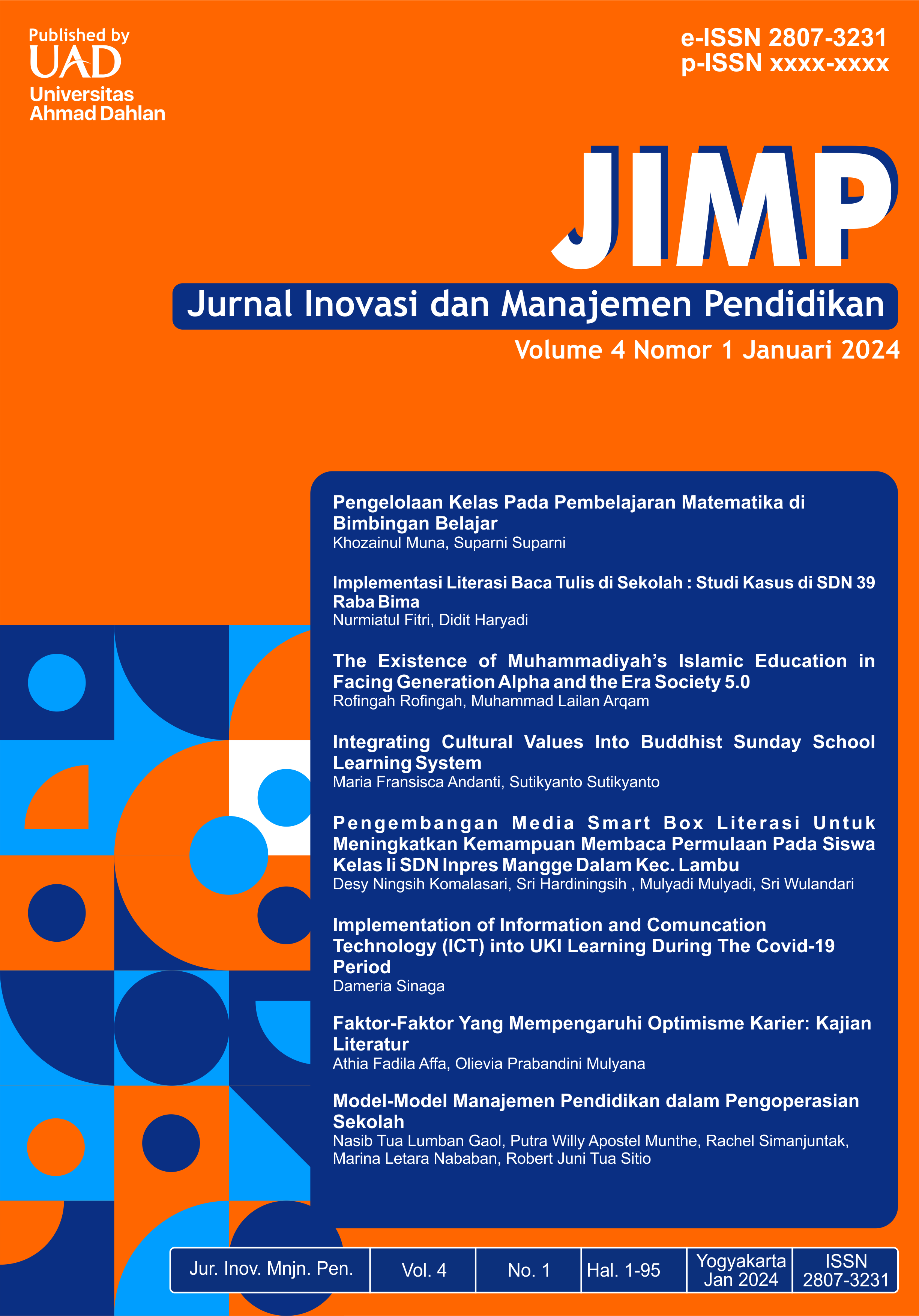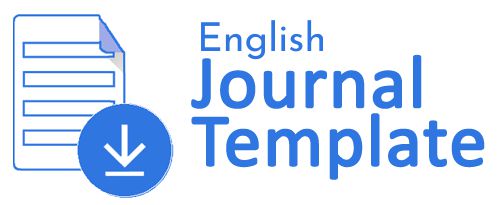Faktor-Faktor Yang Mempengaruhi Optimisme Karier: Kajian Literatur
DOI:
https://doi.org/10.12928/jimp.v4i1.10515Keywords:
Optimisme, Optimisme Karier, KarierAbstract
Pandangan positif seseorang terhadap masa depan tentunya memiliki pengaruh besar untuk mencapai tujuan yang dicapai. Dengan adanya optimisme, seseorang akan cenderung memiliki rasa percaya diri dan membawa dirinya meraih hasil yang terbaik. Optimisme karier adalah sikap seseorang yang memiliki padangan positif terhadap dirinya dengan mengusahakan kemungkinan baik untuk mencapai keberhasilan. Penelitian ini bertujuan untuk mengkaji hasil-hasil studi literatur mengenai faktor-faktor yang mempengaruhi optimisme karier pada seseorang. Penelusuran literatur dilakukan pada database Google Scholar dan Sematic Scholar dengan menggunakan kata kunci “career optimism”. Hasil dari penelusuran menunjukkan bahwa optimisme karier dipengaruhi dua faktor, yakni faktor internal dan eksternal. Faktor internal merupakan faktor yang terbentuk dari dalam individu, sedangkan faktor eksternal merupakan faktor yang terbentuk dari luar individu. Faktor internal yang mempengaruhi optimisme karier, yaitu: efikasi diri, orientasi karier boundaryless, protean karier, serta kepercayaan diri. Adapun faktor eksternal yang mempengaruhi optimisme karier, yaitu: dukungan sosial dan layanan karier yang baik.
References
Ahmad, B., & Nasir, N. (2023). Choose to be Optimistic, it Feels Better! The Role of Career Decision-making Self-efficacy on the Relationship between Boundaryless Career Orientation and Career Optimism. South Asian Journal of Human Resources Management, 10(1), 9–35. https://doi.org/10.1177/23220937221090413
Amalia, F., & Waskito, J. (2024). Pengaruh Protean Career Terhadap Career Optimism Dengan Career Decision Self Efficacy Dan Career Adaptability Sebagai Pemediasi Pada Generasi Milenial Di Surakarta. Jurnal Lentera Bisnis, 13(1), 370. https://doi.org/10.34127/jrlab.v13i1.1038
Chui, H., Li, H., & Ngo, H. (2022). Linking Protean Career Orientation with Career Optimism: Career Adaptability and Career Decision Self-Efficacy as Mediators. Journal of Career Development, 49(1), 161–173. https://doi.org/10.1177/0894845320912526
Delle, E., & Searle, B. (2022). Career Adaptability: The Role of Developmental Leadership and Career Optimism. Journal of Career Development, 49(2), 269–281. https://doi.org/10.1177/0894845320930286
Eva, N., Newman, A., Jiang, Z., & Brouwer, M. (2020). Career optimism: A systematic review and agenda for future research. Journal of Vocational Behavior, 116, 103287. https://doi.org/10.1016/j.jvb.2019.02.011
Fang, W., Zhang, Y., Mei, J., Chai, X., & Fan, X. (2018). Relationships between optimism, educational environment, career adaptability and career motivation nursing undergraduates: A cross-sectional study. Nurse Education Today, 68, 33–39. https://doi.org/10.1016/j.nedt.2018.05.025
Lusiawati, I. (2016). Membangun Optimisme Pada Seseorang Ditinjau Dari Sudut Pandang Psikologi Komunikasi. Jurnal TEDC Bandung, 10(3).
Mawwadah, H. (2019). Analisis Efikasi Diri pada Mahasiswa Psikologi Unimal. Jurnal Psikologi Terapan, 2(2).
Mulfag, F. C. P., Idris, I., Wardi, Y., Rino, R., & Sulastri, S. (2024). Literatur Review: Protean Career. Jurnal Pengabdian Kepada Masyarakat, 30(1).
Olson, K. J., Huffman, A. H., & Litson, K. (2020). The relationship between mentor support experiences and STEM graduate student career optimism. Career Development International, 26(1), 44–64. https://doi.org/10.1108/CDI-07-2019-0171
Rais, M. R. (2022). Kepercayaan Diri (Self Confidence) Dan Perkembangannya Pada Remaja. Jurnal Pendidikan dan Konseling, 12(1).
Rizal, S., Pratitis, N. T., & Arifiana, I. Y. (2023). Peran Efikasi Diri Terhadap Optimisme Karir Pada Mahasiswa Tingkat Akhir. Jiwa: Jurnal Psikologi Indonesia, 1(1).
Rottinghaus, P. J. (2004). Assessing career optimism and adaptability: Toward the construct validation of the Career Futures Inventory [Doctor of Philosophy, Iowa State University, Digital Repository]. https://doi.org/10.31274/rtd-180813-10952
Scott, C. L. (2015). WHAT KIND OF LEARNING FOR THE 21st CENTURY?
Seligman, M. E. P. (1991). Learned optimism. New York: Knopf.
Seligman, M., & Schueller, S. (2008). Optimism and Pessimism. Elsevier Academic Press.
Silalahi, S. G. M., Andi Ina Yustina, & Hajanirina, A. (2023). Linking Boundaryless Career Orientation and Career Optimism: The Moderating Role of Career Decision Self-Efficacy and Career Adaptability. Atestasi : Jurnal Ilmiah Akuntansi, 6(1). https://doi.org/10.57178/atestasi.v6i1.463
Super, D. E. (1980). A life-span, life-space approach to career development. Journal of Vocational Behavior, 16(3), 282–298. https://doi.org/10.1016/0001-8791(80)90056-1
Susilaningrum, H. & Wijono, S. (2023). Dukungan Sosial dengan Work Life Balance pada Pekerja Wanita yang Telah Menikah di PT. X Yogyakarta. Jurnal Inovasi Penelitian, 3(8).
Snyder, C. R., & Lopes, J. S. (2002). Handbook of Positive Psychology. New York: Oxford University Press.
Thompson, D. A., Dent, H. L., & Fine, M. B. (2023). Factors related to a college student’s career optimism and their perception of career services. Higher Education Quarterly, 77(3), 395–409. https://doi.org/10.1111/hequ.12408
Widyanti, R. (2018). Manajemen Karir (Teori, Konsep, dan Praktik). Rizky Artha Mulia.
Downloads
Published
How to Cite
Issue
Section
License
Copyright (c) 2024 Athia Fadila Affa, Olievia Prabandini Mulyana

This work is licensed under a Creative Commons Attribution-ShareAlike 4.0 International License.
This article's copyright is transferred to Universitas Ahmad Dahlan (UAD) if and when the item is accepted for publication. The undersigned hereby transfers any rights in and to the paper including without limitation all copyrights to UAD. The undersigned hereby represents and warrants that the article is original and that he/she is the author of the paper, except for material identified as to its source, with permission notices from the copyright owners where required. The undersigned represents that he/she has the power and authority to make and execute this assignment.
We declare that:
This paper has not been published in the same form elsewhere.
It will not be submitted anywhere else for publication before acceptance/rejection by this Journal.
Copyright permission is obtained for materials published elsewhere and which require this permission for reproduction.
Furthermore, I/We hereby transfer the unlimited rights of publication of the above-mentioned paper in whole to UAD. The copyright transfer covers the exclusive right to reproduce and distribute the article, including reprints, translations, photographic reproductions, microform, electronic form (offline, online), or any other reproductions of similar nature.
The corresponding author signs for and accepts responsibility for releasing this material on behalf of any co-authors. This agreement is to be signed by at least one of the authors who have obtained the co-author(s) assent where applicable. After submission of this agreement signed by the corresponding author, changes of authorship or in the order of the authors listed will not be accepted.
Retained Rights/Terms and Conditions
Authors retain all proprietary rights in any process, procedure, or article of manufacture described in the Work.
Authors may reproduce or authorize others to reproduce the Work or derivative works for the author's personal use or company use, provided that the source and the UAD copyright notice are indicated, the copies are not used in any way that implies UAD endorsement of a product or service of any employer, and the documents themselves are not offered for sale.
Although authors are permitted to re-use all or portions of the Work in other works, this does not include granting third-party requests for reprinting, republishing, or different types of re-use.







